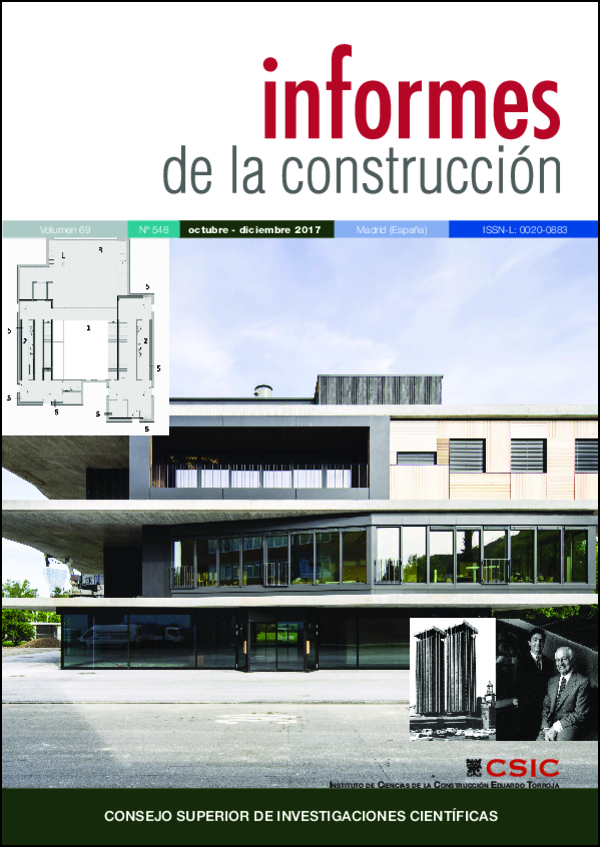The constructive process in the Cimorro zone in the the Cathedral of Avila, (century XII-XIV). Hypothesis and its verification through the analysis of Structural Stability Smart and Sustainable Offices (SSO)
DOI:
https://doi.org/10.3989/ic.16.047Keywords:
Mansonry structure, analysis of Structural Stability, Gothic architecture, Avila Cathedral, system battlementAbstract
This paper presents a hypothesis about the order in the constructive process for the head zone in the Cathedral of Ávila, called Cimorro. The hypothesis proposed in this area considers for its construction three different stages: XII Century, XIII Century and XIV Century. The proposed hypotesis have been verified with the Analysis of Stability realised. The theoretical Framework used is the Limit Analysis to Masonry Structures. After prooving the Structural Stability for each of the building stages, the following conclusions are made: Through the XII Century, the possibility of closing the central vault without Buttress System for a short period of time and the subsequent placement of a tribune is stated. A fortification formed by the barbican and the «adarves» were built during the XIII Century. In the XIV Century, the tribune is removed and replaced with the Buttress System with buttress and double flying buttress, which we can see nowadays.
Downloads
References
(1) Gómez Moreno, M. (3 ed 2007). Catálogo monumental de Ávila Tomo 1. Ávila. Institución Gran Duque de Alba.
(2) Gutiérrez Robledo, J. L. (2000). Arquitectura románica y mudéjar en Ávila. Historia de Ávila 2. Edad Media (siglos VIIIXIII). Ávila. Institución Gran Duque de Alba: 517-584.
(3) Navascués Palacio, P. y Gutiérrez Robledo, J. L. (2004). La catedral de Ávila. Proceso constructivo. Las Edades del Hombre. Testigos: Santa Apostólica Iglesia Catedral, Ávila 2004. Valladolid: Fundación Las Edades del Hombre.
(4) Martín González, G. (2006). Informe sobre la zona del cimorro de la Catedral del salvador de Ávila. Inédito.
(5) Huerta Fernández, S. (2004). Arcos, Bóvedas y cúpulas. Geometría y equilibrio en el cálculo tradicional de estructuras de fábrica. Madrid. Instituto Juan de Herrera, CEHOPU.
(6) Graciani García, A. (2001). Los equipos de obra y los medios auxiliares en la Edad Media. La técnica de la Arquitectura Medieval. 1: 175-209. Sevilla. Publicaciones Universidad de Sevilla.
(7) En esta publicación se detallan todos los documentos de archivo utilizados para la realización de la hipótesis constructiva: Benito Pradillo, M A. (2016). Historia crono-constructiva de la catedral de Ávila. Ávila: Institución Gran Duque de Alba. Excma. Diputación Provincial de Ávila.
(8) Proyecto de Investigación Análisis de técnicas métricas de modelado 3d: aplicación a la reconstrucción virtual del Cimorro de la Catedral de Ávila (Universidad Católica de Ávila, 2009-2011) (Madrid De la Fuente, Carmen (IP); Benito Pradillo, Mª Ángeles; Andaluz Delgado, Soraya; Zancajo Jimeno; José Julio y Mostaza Pérez, Teresa).
(9) Heyman, J. (2001). El esqueleto de piedra. Mecánica de la arquitectura de fábrica. Madrid. Instituto Juan de Herrera.
(10) Rodríguez Almeida, E. (1975). Ensayo sobre la evolución arquitectónica de la Catedral de Ávila. Ávila. Caja Central de Ahorros y Préstamos de Ávila.
(11) Barrios García, A. (1981). Documentación Medieval de la Catedral de Ávila. Salamanca. Universidad de Salamanca.
(12) Benito Pradillo, Mª A. (2011). Evolución constructiva y análisis estructural de la Catedral de Ávila. Tesis doctoral dirigida por la Dra. Gema López Manzanares. Departamento de Estructuras de la Edificación, ETSAM, UPM.
Published
How to Cite
Issue
Section
License
Copyright (c) 2018 Consejo Superior de Investigaciones Científicas (CSIC)

This work is licensed under a Creative Commons Attribution 4.0 International License.
© CSIC. Manuscripts published in both the print and online versions of this journal are the property of the Consejo Superior de Investigaciones Científicas, and quoting this source is a requirement for any partial or full reproduction.
All contents of this electronic edition, except where otherwise noted, are distributed under a Creative Commons Attribution 4.0 International (CC BY 4.0) licence. You may read the basic information and the legal text of the licence. The indication of the CC BY 4.0 licence must be expressly stated in this way when necessary.
Self-archiving in repositories, personal webpages or similar, of any version other than the final version of the work produced by the publisher, is not allowed.















